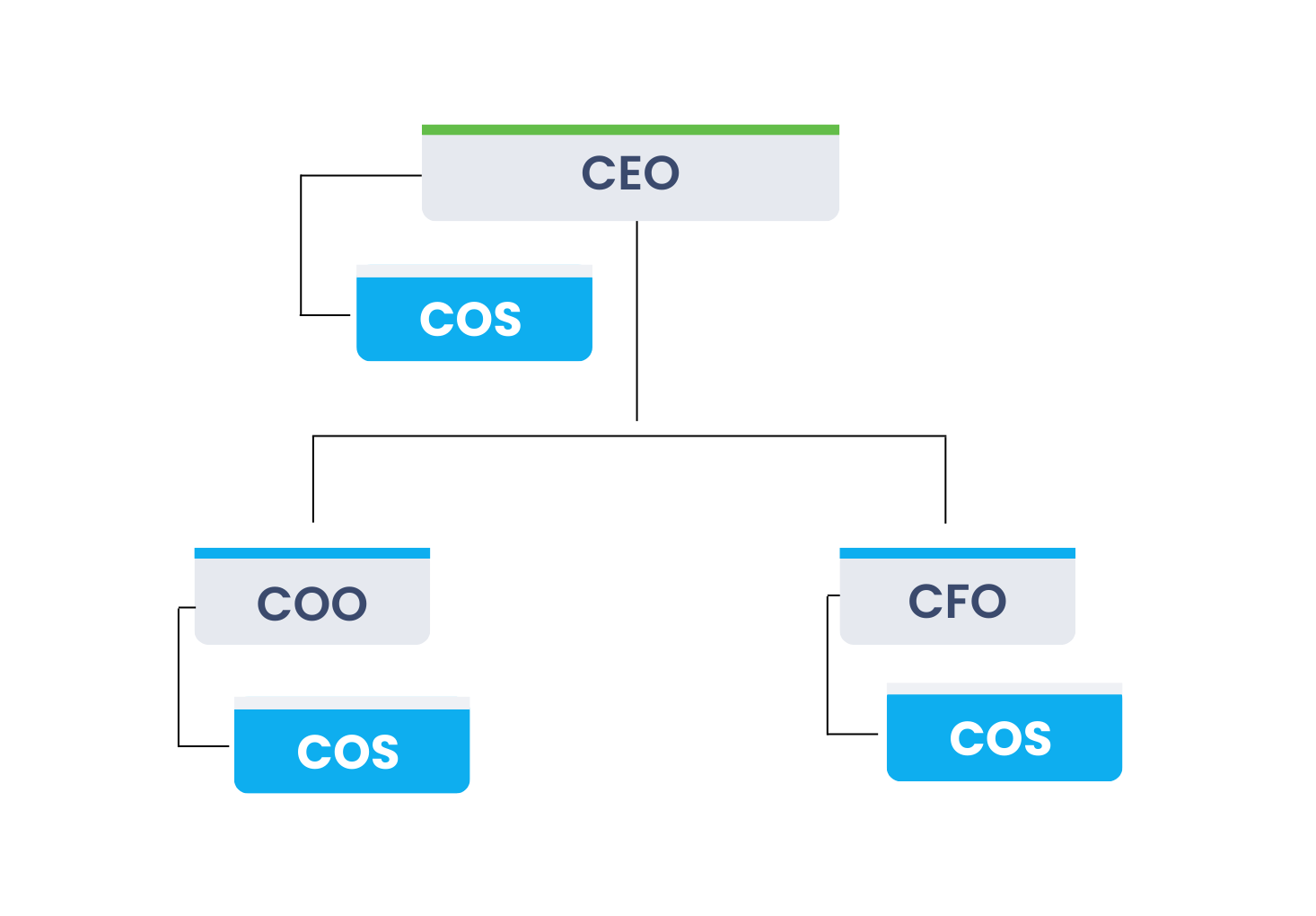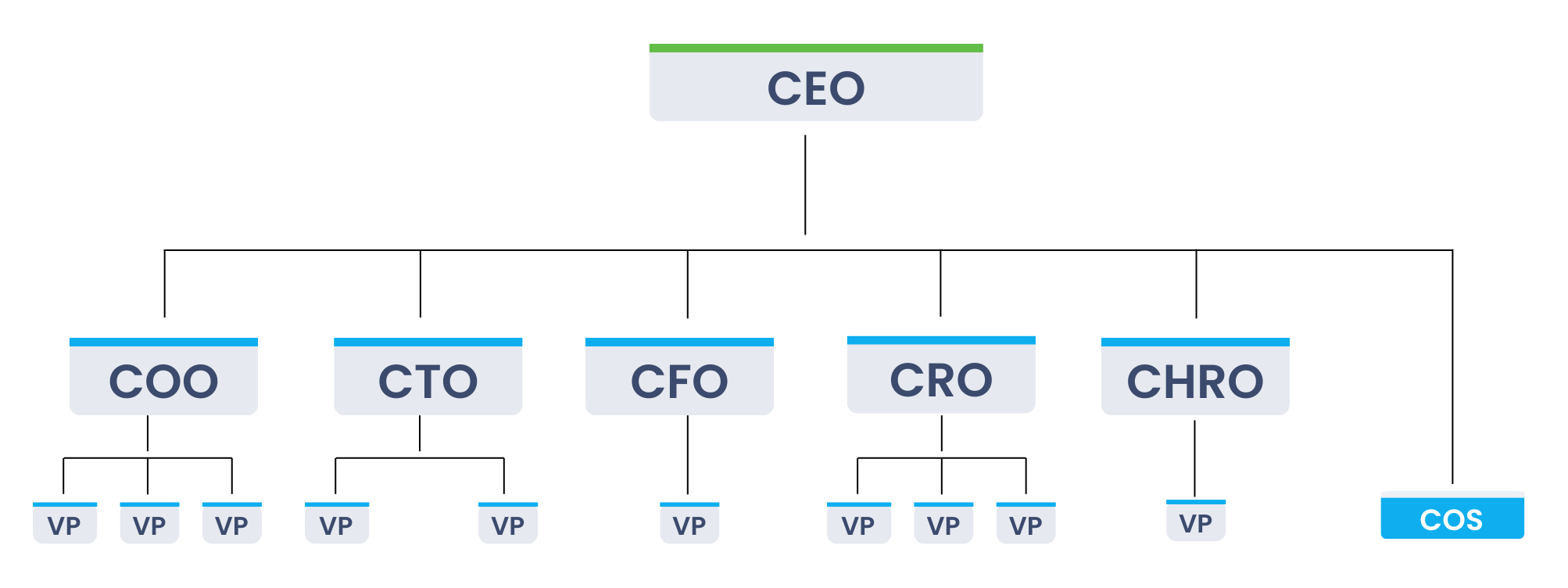Chief of Staff Organizational Chart: Role Essentials
The Chief of Staff (CoS) role has become a critical position in the modern business world as the Chief Executive Officer’s (CEO) right hand. The role is flexible and wide-ranging — it can evolve to meet the needs of various companies across industries, sectors, and company stages.
Some Chiefs of Staff operate within traditional organizational chart structures, while others have complex roles that don’t fit within rigid job descriptions. The responsibilities and requirements of a CoS aren’t always clearly defined, which can make it difficult to envision how the role fits within an org chart. Trust me, when I was a Chief of Staff, it sometimes felt like “explaining my role” was one of my key responsibilities!
Whether supporting the CEO, vice presidents, or the entire executive leadership team, the Chief of Staff is a strategic partner whose efforts allow senior managers to focus on high-level priorities. As an experienced CoS who talks with other current and former Chiefs of Staff every day, I can walk you through some best practices for structuring the Chief of Staff role and optimizing its relationship to other key staff members.
How Organizational Charts Vary Across Company Stages and Sizes
Whether the Chief of Staff has years of experience or they’re just starting out, the role’s structure often varies significantly between larger companies and smaller startups. For example, at large organizations with multi-national reach, VPs sometimes get a Chief of Staff. On the other hand, at a small company, only the CEO will have a CoS.
I once had a guest on my podcast who was the Chief of Staff to a Chief Technology Officer (CTO), mostly because the tech team was the largest one in that org. Therefore, the CTO kind of ran the show day-to-day while the CEO was off “visioning.”
In general, thinking of the Chief of Staff’s role within an org often starts with answering one seemingly simple question…
Who’s Your Principal?
Overall, when people hear "Chief of Staff," they often think of the White House and the President of the United States. But when we're talking about business, the most common principal is the Chief Executive Officer (CEO). I’ve also seen a lot of Chiefs of Staff to Chief Operating Officers (COO), some CoS who reported to the Chief Financial Officer (CFO) or Chief Marketing Officer (CMO), and others who were Chiefs of Staff to a Chief Commercial Officer (CCO) or Chief Human Resources Officer (CHRO).
At some companies, a CoS will have dual principals, supporting both the CEO and the COO. For example, when I was a CoS, I primarily supported the CEO but also worked very closely with our COO/CTO. Sometimes, the Chief of Staff will even support the entire C-Suite.
It’s very common to see the Chief of Staff in a dual role as both the CoS and the COO or VP — or as the Chief of Staff and a Director of Strategic Initiatives or People Ops.
Plus, at larger companies, it’s relatively common to have multiple CoS roles for different C-suite executives, departments, or even geographic regions (either within the United States or worldwide). See why this role can be so hard to envision in an org chart?
How the Chief of Staff and Executive Assistant Interact
This is another big variable, and I’ve seen it work in so many different ways that I won’t possibly try to list them all. But here are four different structures I’ve experienced, with various levels of interaction and direct reports:
The executive assistant (EA) and Chief of Staff report to the same principal.
They work together closely but do very different things and fulfill different functions.
The EA reports to the Chief of Staff.
The CoS handles strategic initiatives, and the EA picks up the administrative tasks.
Multiple executive assistants report to the CoS.
The EAs for the entire C-suite team all trickle up to the Chief of Staff (this is not common but not unheard of either).
The EA reports directly to an executive but also has a “dotted line” to the Chief of Staff.
Promotes communication and cooperation between executive administration and strategy — no one’s left out of the loop.
The Chief of Staff’s relationship with the executive assistant(s) can vary as much as who the CoS role reports to. These factors both play into…
Where the Chief of Staff Fits in the Hierarchy
I see the CoS as a C-suite member — this is where I think the role should live. The Chief of Staff is a strategic decision-maker, an executive problem-solver, and a proxy for the CEO. They handle sensitive information, are on point for company-wide communication, and can act as a public relations liaison. Plus, they often oversee and manage staff meetings, giving them wide-ranging knowledge and relationships across departments.
Chiefs of Staff have a broad overview of a company’s various sectors, and they have the access, visibility, and exposure to the executives that only someone in the C-suite can garner.
“Lower-Level” Chiefs of Staff
That said, this isn’t how it always works — Chiefs of Staff aren’t always viewed as senior positions. I’ve seen companies where the Chief of Staff is thought of as VP-level, and I’ve even seen it as a Director-level position (yikes!). Of course, if the CoS is supporting a VP, they would and should be considered on a different level.
Overall, though, viewing the Chief of Staff as anything less than a C-suite member is a disservice to the importance of the role. Most likely, it’s a result of organizations not understanding how to use and optimize the CoS. [Speaking of, if your org struggles with this, check out my book An Insider’s Perspective on the Chief of Staff: Why You Need One and How to Be a Great One for an in-depth look at this very issue!]
“Higher-Level” Chiefs of Staff
I’ve also seen the Chief of Staff positioned a tiny bit higher — closer to the CEO on org charts. The CoS and CEO work so closely together that the Chief of Staff’s role naturally becomes uniquely important, especially over time as economic growth and other factors expand their responsibilities.
There can also be de-facto dotted-line situations between various executives and the Chief of Staff. Relationships and reporting structures might not be on the official org chart, but they are there and understood by everyone involved.
How to Position and Structure the Chief of Staff Role
As you now know, the role of Chief of Staff can vary considerably — and not just between companies and industries. The CoS position requires flexibility and adaptability, as the tasks and responsibilities can change based on what the senior executives need at any given time.
Filling Gaps as a Company Grows
In growing companies, the CoS often needs to fill gaps throughout the org or oversee specific functions, like business development, talent development, etc. Or, maybe your company needs a COO but doesn’t have one yet — the Chief of Staff can take on a temporary dual role. A great Chief of Staff can help senior leaders lift out of day-to-day operations to focus on more strategic initiatives, especially as a company grows and evolves.
Adapting to Company Stages
Another way to leverage the Chief of Staff’s flexibility is to shift their responsibilities based on the company’s trajectory. Early on, a CoS might wear many hats or have varying roles. As a company settles into its later stages, the Chief of Staff might take point on recruiting and hiring and rounding out the CEO staff (i.e. executive leadership team) shift to a jack-or-jill-of-all trades and a more cross-department, strategic focused role.
Optimizing the Current C-Suite
Sometimes, it’s all about finding that perfect fit with a company’s existing executives. Who does the principal trust? Who can be an honest broker? Who has the most complementary skill set and perspective? Who can get things done behind the scenes to build the team and help get the company where it needs to go? It’s an art as much as a science.
How the Chief of Staff Fits Within Organizational Structures
Think about the leverage points in your organization. What gives the Chief of Staff the most bang for their buck? How can they contribute maximum effects with minimal efforts? Be strategic and always plan ahead — what will the leadership team need within the next 12-24 months, and how can the CoS best move the team and organization towards that outcome?
Let’s walk through some quick scenarios to see how the CoS position can work within the larger organizational context.
Example 1:
A startup has reached an inflection point, trying to professionalize the org and get ready to scale. With all of the changes, some of the founding executives feel that their power is diminishing, and they don’t want to bring in someone on their same level.
Principals and Chiefs of Staff need to keep office dynamics on the radar, so sometimes, it makes sense to bring the CoS in on a “lower” level of an organizational chart to avoid ruffling any feathers (in reality, they may be far more influential and org charts can change over time).
Example 2:
Sometimes, the integration of a private equity firm can really shake things up. Let’s say, there’s a mass exodus of c-suite executives who don’t like the new structure. The VP of Finance has a background running companies, so the PE board promotes them to serve as an interim president.
Meanwhile, a manager with fledgling leadership skills — but a strong understanding of internal processes and customer success — partners up with the new president. The interim president could bring in a CoS they’ve worked with previously to bring everything together. The Chief of Staff can help recruit the new executive team, take responsibilities off the president’s plate, help with board governance, coach and mentor the manager, and more.
Example 3:
A first-time founder partners with a venture capital firm, which pairs that founder with a CoS who has been around the block. The Chief of Staff can operate as a bridge to the VC stakeholders, keeping both the stakeholders and the founder focused on the right areas. The founder is still the subject-matter expert and knows their company and/or industry best, but the CoS helps grease the wheels and keep operations on a smooth pathway to growth.
Example 4:
A large, multi-national company has re-organized — HR and IT are now under the COO’s purview. These are new functional groups for this COO, and they need help coordinating across groups. A great Chief of Staff can coach them on how to lead departments for which the COO lacks technical expertise and help establish a new “rhythm of business” across the new department (i.e. leadership meetings, steering committee meetings, all hands meetings, communication channels, agenda items, decisioning rights, assessment criteria, prioritization, etc.)
How Next Level Coaching Can Help
If you’re struggling to optimize the Chief of Staff role in your organization, or you’re a CoS trying to find your footing, reach out to book a free intro call with me. I can provide the actionable insights you need to transform the Chief of Staff into the indispensable, hyper-valuable position it deserves to be.
About The Author
Emily Sander is an ICF-certified leadership coach with more than 15 years of experience in the business world and the author of Hacking Executive Leadership. She’s been featured in several print publications, online articles, and podcasts, including CEO Today Magazine, Leading to Fulfillment, and Leadership Powered by Common Sense.
Emily has a passion for helping business leaders reach their full potential. Go here to read her story from seasoned executive to knowledgeable coach. If you want to send Emily a quick message, then visit her contact page here.










